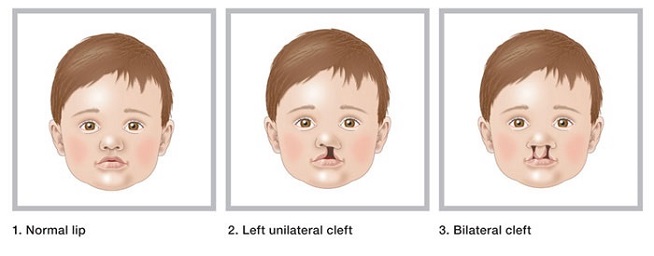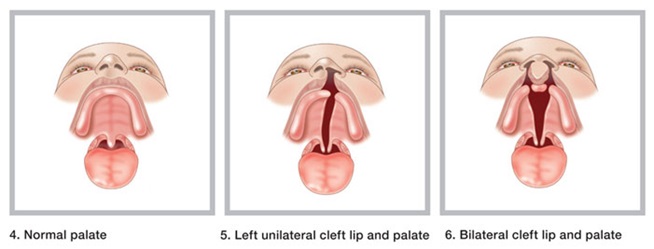Cleft lip and cleft palate
Cleft lip and cleft palate describe an abnormal gap in either the upper lip or the roof of the mouth (the palate). It occurs when some parts of the mouth fail to join together during early pregnancy. The lip and palate develop separately, which means it is possible for a baby to be born with only a cleft lip, only a cleft palate, or a combination of both.
Clefts that occur only on one side are called unilateral clefts. When the cleft affects both sides, it is called a bilateral cleft.
Cleft lip and cleft palate can occur by themselves, or in some cases along with other problems. Most of the time, cleft lip or cleft palate is detected during routine scans in pregnancy.
What causes cleft lip and cleft palates?
Often the cause of a cleft lip and palate is unknown. Sometimes it can happen because there is a family history of the condition. However, sometimes a child is born with the condition when there is no family history and no known cause of the condition.
Treatment
The treatment required for a child with a cleft lip or cleft palate depends on the diagnosis at birth. A cleft lip may need only one operation in the first year of life. A child with a large cleft involving the lip and palate will need several operations. Your child’s surgeon will explain your child’s surgical plan to you.
Your child will usually only need to stay in hospital for one to three days for surgical procedures.Depending on their needs, your child may need to have ongoing care from a cleft team. This might include a/an:
- clinical nurse consultant
- audiologist
- dental specialist
- ear, nose and throat (ENT) surgeon
- oral and maxillofacial surgeon
- paediatrician
- plastic surgeon
- speech pathologist
Your child will see the cleft team from birth until their face has finished growing (usually in their late teens).


Notes
Your child may be affected in a number of ways by a cleft lip and/or palate, and there are a number of important areas to consider in their care.
Hearing
Children affected by cleft palate are more likely to have hearing problems and fluid in the middle ear.
- Every baby with a cleft palate needs to have their hearing monitored closely by a hearing specialist (audiologist). A hearing assessment should be arranged for when your baby is around four weeks old, and repeated again around 12 weeks of age.
- Annual hearing tests are recommended during early childhood for children with a history of cleft palate.
Speech
The palate is very important for speech, therefore some children with a cleft palate might have difficulty talking even after palate repair. Children with a cleft lip but not a cleft palate shouldn’t have any speech issues related to their cleft.
- Children with a cleft palate may have trouble pronouncing consonants (p, b, t, d, k, g, f, v, s, z, sh, ch) and they may have a nasally sounding voice
- They may also make unfamiliar sounds, which make it difficult to understand what your child is saying. This can be very frustrating to the child
- Prior to palate repair, your child should be babbling (e.g. mama, nana) and playing with sounds (e.g. blowing raspberries and kisses), however they may only make a few different sounds until the palate is repaired. Depending on the age of your child when their palate is repaired, they may not yet be using words
- For more information on how to encourage your child’s speech and language development, you can watch the “Supporting Early Communication for Children with Cleft Palate” webinar below
- After surgery, some children may need speech therapy to help eliminate unusual speech errors related to the cleft and to develop the sounds your child needs for speech
You will contacted by the Speech Pathology team when your child is 18 months old to monitor their speech and language development.
